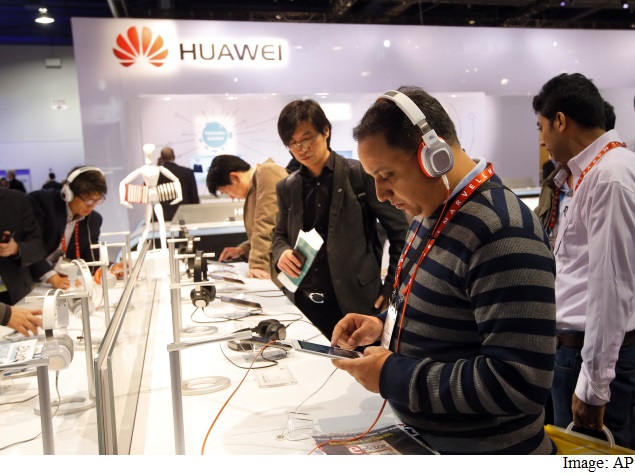- Home
- Mobiles
- Mobiles News
- Huawei Defies China Slowdown That's Enveloping Xiaomi, Samsung
Huawei Defies China Slowdown That's Enveloping Xiaomi, Samsung

The fourth-largest smartphone maker globally missed shipment targets for two years, but a focus shift to high-margin premium models has brought into range its goal of moving 33 percent more handsets than 2014, said a person with knowledge of the matter.
The turnaround comes almost three years after Shenzhen-based Huawei decided to shed its budget appeal and challenge Samsung and Apple Inc at the high-end of the market, where analysts said an increasing number of previously price-conscious Chinese consumers are willing to spend their money.
In contrast to Huawei, overall smartphone shipments in China shrank for the first time in six years in the first quarter, and one-time leader Xiaomi booked its first fall in sequential semi-annual sales, saying the domestic market is nearing saturation.
"There's that buzz going around Huawei in China right now and it's being increasingly associated with better product quality," said Bryan Ma, researcher IDC's Asia-Pacific vice president. "It's quite dramatic how successful they've been."
Behind that success is convincing Chinese consumers that it is worth paying more for its feature-packed yet moderately priced devices, Ma said. Its first-quarter average selling price jumped to $222 from $128 a year earlier, he said.
Huawei will release first-half shipment data and revenue at 9:30 a.m. (0130 GMT) on Wednesday. The company, which also makes telecommunications equipment, reported 30 percent growth in overall revenue on Monday, without providing a breakdown.
Unexpectedly high growth
On Monday, head of consumer business Richard Yu in a memo touted the success of Huawei's high-end P8. The handset is priced in China well below premium models from rivals such as Samsung, which fell out of China's top three in the first quarter for the first time since 2011.
"The consumer business group recorded an unexpectedly high rate of growth," Yu wrote without elaborating. Huawei's consumer business division makes electronic goods such as smartphones, smartwatches, tablet computers and modems.
Analysts said Huawei's sales growth may not be down to company strategy alone, and that it may have benefited from pricing or distribution missteps at competitors.
But now Huawei's fast-growing Honor sub-brand has copied Xiaomi's online distribution model, the triple-digit growth rates Xiaomi has enjoyed in China in recent years may be under threat, said Strategy Analytics executive director Neil Mawston.
"They're cutting into Xiaomi's competitive edge," he said.
© Thomson Reuters 2015
Catch the latest from the Consumer Electronics Show on Gadgets 360, at our CES 2026 hub.
Related Stories
- Samsung Galaxy Unpacked 2025
- ChatGPT
- Redmi Note 14 Pro+
- iPhone 16
- Apple Vision Pro
- Oneplus 12
- OnePlus Nord CE 3 Lite 5G
- iPhone 13
- Xiaomi 14 Pro
- Oppo Find N3
- Tecno Spark Go (2023)
- Realme V30
- Best Phones Under 25000
- Samsung Galaxy S24 Series
- Cryptocurrency
- iQoo 12
- Samsung Galaxy S24 Ultra
- Giottus
- Samsung Galaxy Z Flip 5
- Apple 'Scary Fast'
- Housefull 5
- GoPro Hero 12 Black Review
- Invincible Season 2
- JioGlass
- HD Ready TV
- Laptop Under 50000
- Smartwatch Under 10000
- Latest Mobile Phones
- Compare Phones
- Motorola Signature
- Vivo Y50e 5G
- Vivo Y50s 5G
- Realme 16 Pro+ 5G
- Realme 16 Pro 5G
- TCL Nxtpaper 70 Pro
- OPPO A6 Pro 5G
- Honor Power 2
- Lenovo Yoga Slim 7x (2025)
- Lenovo Yoga Slim 7a
- Realme Pad 3
- OPPO Pad Air 5
- Xiaomi Watch 5
- Huawei Watch 10th Anniversary Edition
- Acerpure Nitro Z Series 100-inch QLED TV
- Samsung 43 Inch LED Ultra HD (4K) Smart TV (UA43UE81AFULXL)
- Asus ROG Ally
- Nintendo Switch Lite
- Haier 1.6 Ton 5 Star Inverter Split AC (HSU19G-MZAID5BN-INV)
- Haier 1.6 Ton 5 Star Inverter Split AC (HSU19G-MZAIM5BN-INV)

















